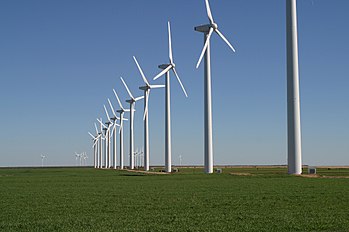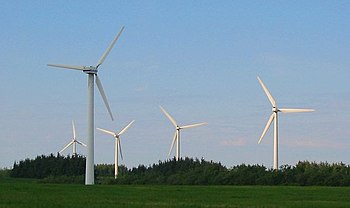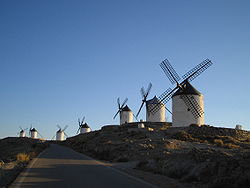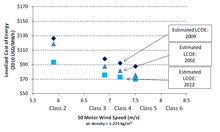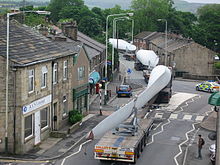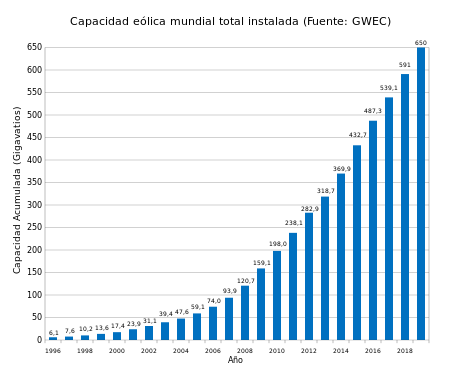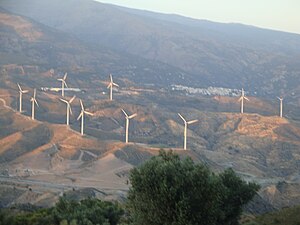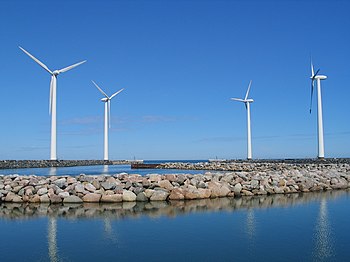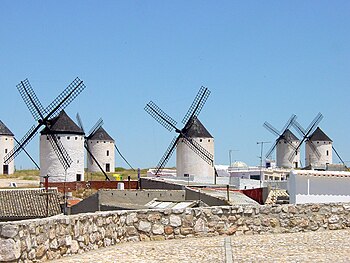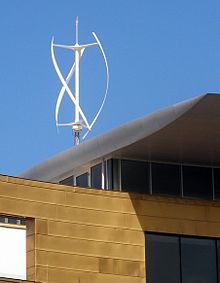Wind power
Wind energy is the energy obtained from the wind, that is, it is the use of the kinetic energy of the air masses.
The term "eolian" comes from the Latin aeolicus, or 'belonging or relating to Aeolus', god of the winds in Greek mythology.
Currently, wind energy is mainly used to produce electricity, which is achieved through wind turbines connected to large electricity distribution networks, among others. Onshore wind farms represent an increasingly cheap and competitive source of energy. It is even cheaper in many regions than other conventional energy sources. In addition, electricity can be provided in isolated regions that do not have access to the electricity grid through small wind farms, or also with photovoltaic solar energy. The electricity distribution companies increasingly acquire the surplus electricity produced by small domestic wind farms. The rise of wind energy has also led to the planning and construction of offshore wind farms —that is, they are located in the sea—, near the coasts. Wind power is more stable and strong at sea than on land, and offshore wind farms have less visual impact, although construction and maintenance costs are considerably higher.
At the end of 2016 , the world's installed wind power capacity was 370 GW, generating around 5% of the world's electricity consumption. Denmark generates more than 25% of its electricity from wind power, and more than 80 countries around the world use it. increasingly used to provide electricity in their distribution networks, increasing their capacity annually with rates above 20%. In Spain, wind energy produced 20.3% of the electricity consumption on the peninsula in 2014, becoming the technology with the second highest contribution to demand coverage, very close to nuclear energy with 22.0%.
Wind power is an abundant, renewable, and clean resource that helps reduce greenhouse gas emissions by replacing fossil fuel-based power sources. The environmental impact of this type of energy is also generally less problematic than that of other energy sources.
Wind energy is quite stable and predictable on an annual scale, although it presents significant variations on shorter time scales. As the proportion of wind energy produced in a certain region or country increases, it becomes essential to establish a series of improvements in the local electrical network. Various energy control techniques, such as a greater energy storage capacity, a wide geographical distribution of wind turbines, the availability of backup power sources, the possibility of exporting or importing energy to neighboring regions or the reduction of demand when wind production is lower, can help to greatly mitigate these problems. In addition, they are Wind energy production forecasts are extremely important, as they allow electricity grid managers to be prepared and anticipate against foreseeable variations in wind energy production that may take place in the short term.
How it is produced and generated
Wind energy is related to the movement of air masses that move from areas of high atmospheric pressure to adjacent areas of lower pressure, with speeds proportional to the pressure gradient and thus be able to generate energy.
Winds are generated due to non-uniform heating of the earth's surface due to solar radiation; Between 1 and 2% of the energy coming from the Sun is converted into wind. During the day, the continents transfer a greater amount of solar energy to the air than the masses of water, causing the air to heat up and expand, thus becoming less dense and rising. The colder and heavier air that comes from the seas, oceans and large lakes moves to take the place left by the warm air.
In order to take advantage of wind energy, it is important to know the diurnal, nocturnal and seasonal variations of the winds, the variation of the wind speed with the height above the ground, the entity of the gusts in short periods of time, and the maximum values occurred in historical data series with a minimum duration of 20 years. In order to use the energy of the wind, it is necessary for it to reach a minimum speed that depends on the Wind Turbine that is going to be used but that usually starts between 3 m/s (10 km/h) and 4 m/s (14, 4 km/h), speed called "cut-in speed", and that does not exceed 25 m/s (90 km/h), speed called cut -out speed.
Wind energy is harnessed through the use of wind machines or aeromotors capable of transforming wind energy into usable mechanical rotation energy, either to directly drive the operating machines or for the production of electrical energy. In the latter case, the most widely used today, the conversion system —which includes an electric generator with its control systems and connection to the grid— is known as a wind turbine. In these, wind energy moves a propeller and through a mechanical system the rotor of a generator is rotated, usually an alternator, which produces electrical energy. For their installation to be profitable, they are usually grouped into concentrations called wind farms.
A wind turbine is a machine that transforms wind energy into mechanical energy through oblique blades attached to a common axis. The rotating shaft can be connected to various types of machinery, be it for grinding grain (mills), pumping water or generating electricity. When used to produce electricity it is called a wind turbine generator. Machines moved by the wind have a remote origin, the oldest being those that functioned as mills.
Wind energy is the energy that is obtained from the wind or, in other words, it is the use of the kinetic energy of the air masses that can be converted into mechanical energy and from it into electricity or other useful forms of energy in daily human activities.
History
Wind energy is not something new, it is one of the oldest energies together with thermal energy. The wind as a driving force has been used since ancient times. Thus, it has moved ships through the use of sails or has made the machinery of the mills work by moving their blades. However, after a time when it was gradually abandoned, from the eighties of the XX century, this type of energy Clean experienced a renaissance.
Wind energy is growing unstoppably already in the XXI century, in some countries more than in others, but without There is no doubt that there is great growth in Spain, being one of the first countries, below Germany at a European level or the United States at a global level. The boom in the increase in wind farms is due to favorable wind conditions, especially in Andalusia, which occupies a leading position, among which the Gulf of Cádiz can be highlighted, since the wind resource is exceptional.
The first mills
The oldest known reference is a windmill that was used to power an organ in the 1st century. The first mills of practical use were built in Sistan, Afghanistan, in the 7th century. These were vertical-shaft mills with rectangular blades. Wheat-grinding or water-drawing devices made from 6 to 8 cloth-covered mill blades were used.
In Europe
The first mills appeared in Europe in the 12th century in France and England and spread across the continent. They were wooden structures, known as mill towers, which were rotated by hand around a central post to spread their blades into the wind. The tower mill was developed in France throughout the 14th century century. It consisted of a stone tower crowned by a rotating wooden structure that supported the axis of the mill and its upper machinery.
These early specimens had a number of common features. A horizontal shaft protruded from the top of the mill. Four to eight blades started from this axis, with a length between 3 and 9 meters. The wooden beams were covered with cloth or wooden planks. The energy generated by the rotation of the shaft was transmitted, through a system of gears, to the mill machinery located at the base of the structure.
Horizontal shaft mills were used extensively in Western Europe to grind wheat from the 1180s onward. Just remember the famous windmills in the adventures of Don Quixote. Machines of this type still exist, for example, in the Netherlands for drawing water.
Pumping with wind energy
In the United States, the development of wind-powered pumps, recognizable by their multiple metal blades, was the primary factor enabling agriculture and ranching in vast areas of North America otherwise impossible without easy access to water. These pumps contributed to the expansion of the railway around the world, covering the water needs of steam locomotives.
Modern turbines
Modern wind turbines were developed in the early 1980s. They began in 1979 with the series production of wind turbines by manufacturers Kuriant, Vestas, Nordtank, Nily Baltazar and Bonus. Those turbines were small by today's standards, with capacities of 20 to 30 kW each. Since then, the size of the turbines has grown enormously, and production has expanded to many parts of the world.
Use of wind energy
In order to take advantage of wind energy, it is important to know the diurnal and nocturnal and seasonal variations of the winds, the variation of the wind speed with the height above the ground, the entity of the gusts in short periods of time, and values maximums occurred in historical data series with a minimum duration of 20 years. It is also important to know the maximum wind speed. In order to use the energy of the wind, it is necessary for it to reach a minimum speed that depends on the wind turbine that is going to be used but that usually starts between 3 and 4 m/s (10-14.4 km/h), speed called cut-in speed, and that does not exceed 25 m/s (90 km/h), speed called cut-out speed.
Wind energy is used through the use of wind machines (or aeromotors) capable of transforming wind energy into usable mechanical rotation energy, either to directly drive the operating machines, or for the production of electrical energy. In the latter case, the conversion system (which includes an electric generator with its control and connection systems to the grid) is known as a wind turbine.
Cost of wind energy
Wind power reached grid parity (the point at which the cost of wind power is equal to or less than other traditional energy sources) in some areas of Europe and the United States in the mid-2000s Falling costs continue to drive down the normalized cost of this renewable energy source: it is estimated to have reached grid parity across the European continent around 2010, and to reach the same point in across the United States in 2016, due to an additional 12% reduction in their costs.
The installation of wind energy requires a considerable initial investment, but subsequently does not present fuel costs. The price of wind energy is therefore much more stable than the prices of other fossil energy sources, which are much more volatile. The marginal cost of wind power, once the plant has been built and is running, is generally less than 1 cent per kWh. This cost has even been reduced with the technological improvement of older turbines. recent. There are increasingly longer and lighter blades for wind turbines on the market, while improvements are constantly made in the operation of the machinery of the wind turbines themselves, increasing their efficiency. Likewise, the initial investment and maintenance costs of the wind farms have been reduced.
By 2004, the cost of wind power had dropped to a fifth of what it was in the 1980s, and experts believe the downward trend will continue in the near future, with the introduction of wind power to the market. new, increasingly large, mass-produced "multi-megawatt" wind turbines, capable of producing up to 8 megawatts of power per unit. In 2012, the capital costs of wind power were substantially lower than in 2008–2010, although they were still above the levels of 2002, when they reached an all-time low. The drop in other costs has contributed to reaching increasingly competitive prices. A 2011 report from the American Wind Energy Association stated:
The costs of wind energy have fallen over the last two years, recently placing itself in the order of 5-6 cents per kWh... about two cents cheaper than the electricity obtained in coal plants. [...] 5600 MW of new installed capacity are currently under construction and the United States, more than double that installed until 2010. Thirty-five percent of the new generation capacity built in the United States since 2005 comes from wind energy, rather than the sum of new capacity from gas and coal plants, as energy providers are increasingly attracted to wind energy as a reliable resource against unpredictable movements in the prices of other energy sources.
Another report from the British Wind Energy Association estimates an average generation cost for onshore wind of 5-6 US cents per kWh (2005). The cost per unit of power produced was estimated in 2006 to be comparable to the cost of energy produced in new generation plants in the United States from coal and natural gas: the cost of wind was estimated at $55.80/MWh, that of coal at $53.10/MWh and that of natural gas at $52.50/MWh. Another government report obtained similar results compared to natural gas, in 2011 in the United Kingdom. In August 2011, tenders in Brazil and Uruguay for 20-year purchase presented costs below $65/MWh.
In February 2013, Bloomberg New Energy Finance reported that the cost of generating power from new wind farms in Australia is less than that from new coal or gas plants. Including the current pricing scheme for fossil fuels in the calculations, their estimates indicated costs (in Australian dollars) of $80/MWh for new wind farms, $143/MWh for new coal plants and $116/MWh for new coal plants. gas. This model further shows that “even without a tax on carbon emissions (the most efficient way to reduce emissions on a large scale) wind power is 14% cheaper than new coal plants, and 18% cheaper than new ones.” new gas plants".
The wind industry in the United States is currently able to produce more power at a lower cost thanks to the use of increasingly tall wind turbines with longer blades, thus capturing greater winds at higher altitudes. This has opened up new opportunities, and in states like Indiana, Michigan, and Ohio, the cost of wind from turbines 300 to 400 feet tall can compete with conventional power sources like coal. Prices have fallen as low as 4 cents per kWh in some cases, and distribution companies are increasing the amount of wind power in their energy model, increasingly realizing their competitiveness.
The cost of the unit of energy produced in wind farms is deduced from a rather complex calculation. Various factors must be taken into account for its evaluation, including:
- The initial cost or initial investment: the cost of the wind turbine is about 60% or 70%. The average cost of a wind power plant is, today, about 1200 euros per kilowatt of installed and variable power according to the technology and brand to be installed (direct drive, syncs, asynchronous or permanent magnet generators).
- The service life of the installation (approximately 20 years) and the amortization of this cost.
- Financial costs.
- Operating and maintenance costs (variable between 1 and 3 % of the investment);
- The global energy produced in a period of one year, that is, the plant factor of the installation. This is defined according to the characteristics of the wind turbine and the characteristics of the wind in the place where it has been installed. This calculation is quite simple since the power curves certified by each manufacturer are used and are usually guaranteed between 95 and 98 % according to each manufacturer. For some of the machines that have been operating for more than 20 years, it has reached 99% of the power curve.
Production by country
There are a large number of wind turbines in operation, with a total capacity of 369,597 MW at the end of 2014, of which Europe has 36.3%. China and the United States together account for almost 50% of the global wind capacity, while the top five countries (China, United States, Germany, Spain and India) accounted for 71.7% of global wind capacity in 2014.
Germany, Spain, the United States, India and Denmark have made the largest investments in wind power generation. Denmark is, in relative terms, the most prominent in terms of manufacture and use of wind turbines, with a commitment made in the 1970s to get half of the country's energy production from the wind. In 2014, it generated 39.1% of its electricity from wind turbines, the highest percentage of any other country, and the previous year wind power established itself as the cheapest energy source in the country.
The following table shows the total installed wind power capacity at the end of each year (in megawatts) worldwide, broken down by country. Data published by the Global Wind Energy Council (GWEC).
Wind energy in Spain
At the end of 2018, Spain had an installed wind power capacity of 23,507 MW, which represents 22.6% of the capacity of the national electricity system, the second source of energy in the country behind the combined cycle with 26,284 MW. It thus ranks fourth in the world in terms of installed power, behind China, the United States and Germany. That same year, wind energy produced 49,570 GWh, 18.4% of electricity demand.
On January 29, 2015, wind energy reached a maximum of instantaneous power with 17,553 MW, covering 45% of the demand.
On December 8, 2021, wind energy reached a maximum of instantaneous power with 20,034 MW, covering 58.9% of the demand.
Likewise, the small wind sector is growing a lot. There is a regulation for the manufacture of small wind turbines, from the CEI International Electrotechnical Committee (Standard IEC-61400-2 Ed2) which defines a small power wind turbine as one whose area swept by its rotor is less than 200 m². The power that corresponds to said area will depend on the quality of the design of the wind turbine, existing up to 65 kW maximum.
Wind power in the UK
The United Kingdom closed 2008 with 4,015 MW of wind power installed, which represents a token presence in its electricity production. However, it is one of the countries in the world with the most wind capacity planned, and it has already granted concessions to reach 32,000 MW offshore wind power off its coasts:
- Dogger Bank; 9000 MW; North Sea; Forewind * (SSE Renewables, RWE Npower Renewables, StatoilHydro & Statkraft)
- Norfolk Bank; 7200 MW; North Sea; *Renewable Iberdrola (ScottishPower) & Vattenfall
- Ireland Sea; 4100 MW; Ireland Sea; Central
- Hornsea; 4000 MW; North Sea; * Mainstream Renewables, Siemens & Hochtief Construction
- Ría del Forth; 3400 MW; Scotland; SeaGreen * (SSE Renewables and Fluor)
- Bristol Channel; 1500 MW; Southwest Coast; RWE Npower Renewables
- Ría de Moray; 1300 MW; Scotland; * EDP Renewable " SeaEnergy
- Isle of Wight (West); 900 MW; South; Enerco New Energy
- Hastings; 600 MW; South; E.On Climate & Renewables
According to the UK administration, “the offshore wind industry is one of the keys to the UK's path towards a low CO2 economy and should be worth around 75 billion pounds (eighty-four billion euros) and support some 70,000 jobs until 2020."
Wind power in Sweden
Sweden closed 2009 with 1,021 MW of wind power installed and has plans to reach 14,000 MW in 2020, of which between 2,500 and 3,000 MW will be offshore.
Other European countries
- Wind energy in Croatia
- Wind energy in Italy
- Wind energy in Romania
- Wind energy in Turkey
Wind energy in Central and South America
The development of wind energy in the countries of Mexico, Central America, and South America is in its infancy, and the joint installed capacity in them, until the end of 2021, reaches 39,447 MW. The breakdown of installed capacity by country is as follows:
- Brazil: 21161 MW
- Mexico: 7692 MW
- Argentina: 3292 MW
- Chile: 3137 MW
- Uruguay: 1514 MW
- Colombia: 510 MW
- Peru: 409 MW
- Costa Rica: 394 MW
- Dominican Republic: 370 MW
- Panama: 270 MW
- Honduras: 241 MW
- Nicaragua: 186 MW
- Other countries: installed power below 185 MW
- Central America + Caribbean: 2001 MW
- South America: 29754 MW
At the end of 2021, Brazil was the 4th largest producer of wind energy in the world (72 TWh), only behind China, the US and Germany. The country has been preparing to install offshore wind power by 2030. The wind potential of the Patagonia region is considered gigantic, with estimates that the area could provide enough electricity to sustain the consumption of a country like Brazil alone. However, Argentina has infrastructure deficiencies to carry out the transmission of electrical energy from uninhabited areas with a lot of wind to the large centers of the country.
Wind power in Africa
At the end of 2013, the accumulated installed power by countries of the continent is as follows:
Disadvantages of wind power
Technical aspects
Due to the natural variability and unpredictability of the wind, in order for wind energy to be used as the only source of electrical energy, it is necessary to store the energy that is produced when there is wind to be able to use it later when there is not. But so far there are no systems large enough to store considerable amounts of energy efficiently, except for pumping stations. Therefore, in order to face the valleys in the wind energy production curve and avoid widespread blackouts, a backup of conventional energies such as coal, natural gas, oil or combined cycle thermoelectric plants or reversible hydroelectric plants is essential, for example. This is an inconvenience, since when they support wind, coal plants cannot work at their optimum performance, which is close to 90% of their power. They have to stay well below this percentage to be able to substantially increase their production by the time the wind dies down. That is why, when operating in this mode, thermal power plants consume more fuel per kWh produced.[citation needed] In addition, by increasing and decreasing their production each time When the wind speed changes, there is greater wear on the machinery.[citation required] This backup problem in Spain is going to be solved through an interconnection with France that allow the use of the European system as a cushion for wind variability.[citation needed] In addition, the variability in wind energy production has other important consequences:
- In order to distribute the electricity produced by each wind farm (which is usually also located in remote natural landscapes) it is necessary to build high voltage lines that are able to drive the maximum of electricity that is capable of producing the installation.
- Technically, one of the greatest inconveniences of wind turbines is the so-called tension gap. In the face of one of these phenomena, the protections of aerogenerators with squirrel cage engines cause the disconnection of the network to avoid being damaged and consequently new disturbances in it, in this case, of lack of supply. This problem is solved well by changing the electrical system of turbines, which is quite costly, either by using synchronous engines, although it is quite easier to make sure that the network to which it is to be connected is strong and stable.
- In addition to the obvious need for a minimum speed in the wind to be able to move the blades, there is also a higher limitation: a machine may be generating to the maximum of its power, but if the speed of the wind exceeds the specifications of the aerogenerator, it is mandatory to disconnect it from the network or change the inclination of the blades to stop turning, since its structure may be damaged by the efforts that appear on the axis. The immediate consequence is an obvious decline in electricity production, despite winding in abundance, and it is another factor of uncertainty when it comes to having this energy in the power grid.
Although these problems seem unique to wind energy, they are common to all naturally occurring energy sources:
- A solar panel will only produce energy while there is enough sunlight.
- A hydroelectric power plant can only produce as long as water conditions and precipitation allow water release
One of the ways to alleviate the lack of control over renewable resources (wind, solar radiation), are the so-called hybrid systems, where energy sources are combined with storage. There is a trend towards the creation of renewable power plants involving wind and solar generators and battery storage (usually lithium ion). In countries like Australia or the United States, their use is being regulated and specific tariffs are even being defined for the injection of energy from these plants that are beginning to compete on an equal footing with plants based on fossil fuels, since they begin to have a forecast of generation within a day or more.
Environmental aspects
- Generally, although not always, it is combined with thermal power plants, which leads some people to consider that not too much carbon dioxide emissions are actually saved. However, it must be borne in mind that no renewable energy allows, at least on its own, to cover all demand and electricity production, but its contribution to the electricity grid is clearly positive from the point of view of emissions savings.
- There are wind farms in Spain in protected areas such as ZEPA (Special Protection Zone for Birds) and LIC (community area) of the Natura 2000 Network, which means a natural impact – if not reduced – due to human activity.
- At the beginning of their installation, the places selected to do so coincided with the routes of migratory birds or with the areas where birds take advantage of slope winds, which makes the turbines enter into conflict with birds and bats. Fortunately, the levels of mortanity are very low compared to other causes such as abuses, although this claim is questioned by independent experts.[chuckles]required] Currently the environmental impact studies necessary for the recognition of the plan of the wind farm take into consideration the ornithological situation of the area. Moreover, given that current turbines are of low rotation speed, the problem of collision with birds is significantly reduced.
- The landscape impact is an important note due to the layout of the horizontal elements that make up it and the appearance of a vertical element such as the wind turbine. They produce the so-called " discotheque effect": this appears when the sun is behind the mills and the shadows of the aspas are projected regularly on the gardens and the windows, blinking in such a way that people named this phenomenon " discotheque effect". This, coupled with noise, can lead people to a high level of stress, with health consideration effects. However, the improvement of the design of turbines has allowed the progressive reduction of the noise they produce.
- The opening of wind farms and the presence of operators in them makes the human presence constant in places until then untraveled, which also affects the fauna.
Advantages of wind energy
- It is a type of renewable energy since it has its origin in atmospheric processes due to the energy that reaches the Earth from the Sun.
- It is a clean energy by not requiring combustion, so it does not produce atmospheric emissions or polluting waste, thus avoiding an increase in the greenhouse effect and climate change.
- It can be installed in spaces not suitable for other purposes, for example in desert areas, near the coast, on arid slopes or very steep to be cultivable.
- It can live with other soil uses, for example grasslands or low crops such as wheat, corn, potatoes, beetroot, etc.
- It creates a high number of jobs in assembly plants and installation areas.
- Its installation is fast, between 4 and 9 months.
- Its inclusion in an electric network allows, when the conditions of the wind are adequate, to save fuel in the thermal and/or water plants in the reservoirs of the hydroelectric plants.
- Its use combined with other types of energy, usually the photovoltaic solar energy, allows the self-feeding of homes, achieving autonomy over 82 hours and thus ending with the need to connect to supply networks.
- The current physical situation dispersed in countries such as Spain makes it possible to compensate for the low production of wind farms due to lack of wind with high production in other areas. In this way the waveform produced in the electrical generation is stabilized, solving the problems that the turbines presented as energy producers at the beginning.
- It is possible to build wind farms at sea, where the wind is stronger, more constant and the social impact is less, although installation and maintenance costs increase. Parks offshore they are especially important in the countries of northern Europe such as Denmark.
Wind power microgeneration
Microgeneration of wind energy consists of small generation systems of up to 50 kW of power. In remote and isolated communities, which have traditionally used diesel generators, its use is a good alternative. It is also increasingly being used by households installing these systems to reduce or eliminate their dependency on the electricity grid for economic reasons, as well as to reduce their environmental impact and carbon footprint. These types of small turbines have been used for several decades in remote areas together with battery storage systems.
Small, grid-connected wind turbines can also use what is known as on-grid storage, replacing power purchased from the grid with locally produced power, where possible. The surplus energy produced by domestic microgenerators can, in some countries, be poured into the network for sale to the electricity company, generating income for the owner of the installation that amortizes the installation.
Systems disconnected from the grid can adapt to the intermittency of the wind, use batteries, photovoltaic systems or diesel generators that complement the energy produced by the turbine. Other equipment, such as parking meters, illuminated traffic signs, public lighting, or telecommunications systems, can also be powered by a small wind turbine, generally together with a photovoltaic system that charges small batteries, eliminating the need for a connection to the grid..
Small wind could generate electricity cheaper than grid power in some rural areas of the UK, according to a study by the Carbon Trust, published in 2010. According to that report, mini wind turbines could potentially generate 1. 5 TWh of electricity per year in the United Kingdom, 0.4% of the country's total consumption, avoiding the emission of 600,000 tons of CO2. This conclusion is based on the assumption that 10% of households installed mini wind turbines at prices competitive with those of the electricity grid, around 12 pence (about €0.17) per kWh. Another report prepared in 2006 by Energy Saving Trust, an organization under the UK Government, ruled that micro-generation (of different types: wind, solar, etc.) could provide up to 30-40% of electricity demand around the year 2050.
Distributed generation from renewable energies has increased in recent years, as a result of greater awareness about the influence of humans on climate change. The electronic equipment required to allow the connection of renewable generation systems to the electricity grid may also include other grid stability systems to ensure and guarantee the quality of the electricity supply.
Contenido relacionado
Thermal inertia
Railway modeling
Paraboloid
